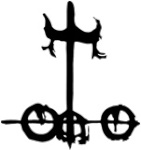Mitsuoka cross
Christian crosses appear in various forms and this one was particularly intriguing.
It includes several adornments, such as a shroud hanging from the cross bar which has three vertical parts representing the Holy Trinity.
The additional pair of smaller crosses at the base result in the Three Crosses of Calvary. The central circle at the base being the skull of Golgotha, and no doubt other parts that we've not interpreted so far.
But...
Fun fact
The design is not meant to be Christian at all. It's the logo of a Japanese car company called Mitsuoka, noted for their unique models, some of which are rather eccentric. It's a small company with very few showrooms even in Japan, though one just happens to be a few minutes' walk from my home, so I was able to pop in and confirm the accuracy of this page.
The company is named after its founder and current president, Akio Mitsuoka (光岡章夫), and the first kanji of his name (光) is not dissimilar to the top part of the company's logo. That kanji means "light" (as in bright, not as in lightweight). But no, the top of the logo does not mean light.
So what does it mean?
Several websites show the logo is from the Japanese kanji character (車) which means "karuma" (car). However, that's not easy to reconcile.
 Mitsuoka |
= ? = |  karuma |
Unlike the logo, you'll note that Japanese kanji never includes circles
But that's not always been the case. The earlier Chinese characters were pictograms which sometimes included circles, especially to represent wheels.
You'll also notice the lines of this kanji character have straight edges and sharp corners, which is invariably the case in printed form. The earlier Chinese characters were brushed and also carved on bones, which we see in the rough strokes of the Mitsuoka logo.
If we research back to earlier forms of this character, we see how it evolved. And when we say "back", we mean way back to the early Bronze Age.
The Shang Dynasty (aka Yin dynasty) ruled in China from 1600 to 1046 BC. They advanced art in the form of mathematics, astronomy and warfare techniques, with the aid of ox scapula (shoulder blade) and turtle plastron (shell).
Questions for the gods were carved on bones or plastra and subjected to heat until they cracked. The pattern created by the crack was then interpreted by a diviner who would add the interpretation to the piece.
Relics discovered were called "oracle bones" by Frank H Chalfant (1862–1914), an American missionary.
The pictogram for rickshaw, cart, chariot (and now Mitsuoka!) can be seen below in the Oracle Bone script period. There are various (vertical and horizontal) pictographs of two wheels, a cargo space between, and a long shaft attached to the yoke pulled by two rickshaw bearers of domesticated beasts.
The vertical form in the Clerical script comes from the rock carving named Shi xia song from the late Han dynasty (206 BC – 220 BC).
 |
→ |  |
| Oracle bone script | Clerical script |
So that's the description of the logo. For the Mitsuoka hearses, roadsters, and unconventional (quirky) eye-catching cars, see mitsuoka-motor.com.
Cars "Made in Japan" with a logo "Made in China".
See also:
and please tell us if you know any other car marque which includes a cross.